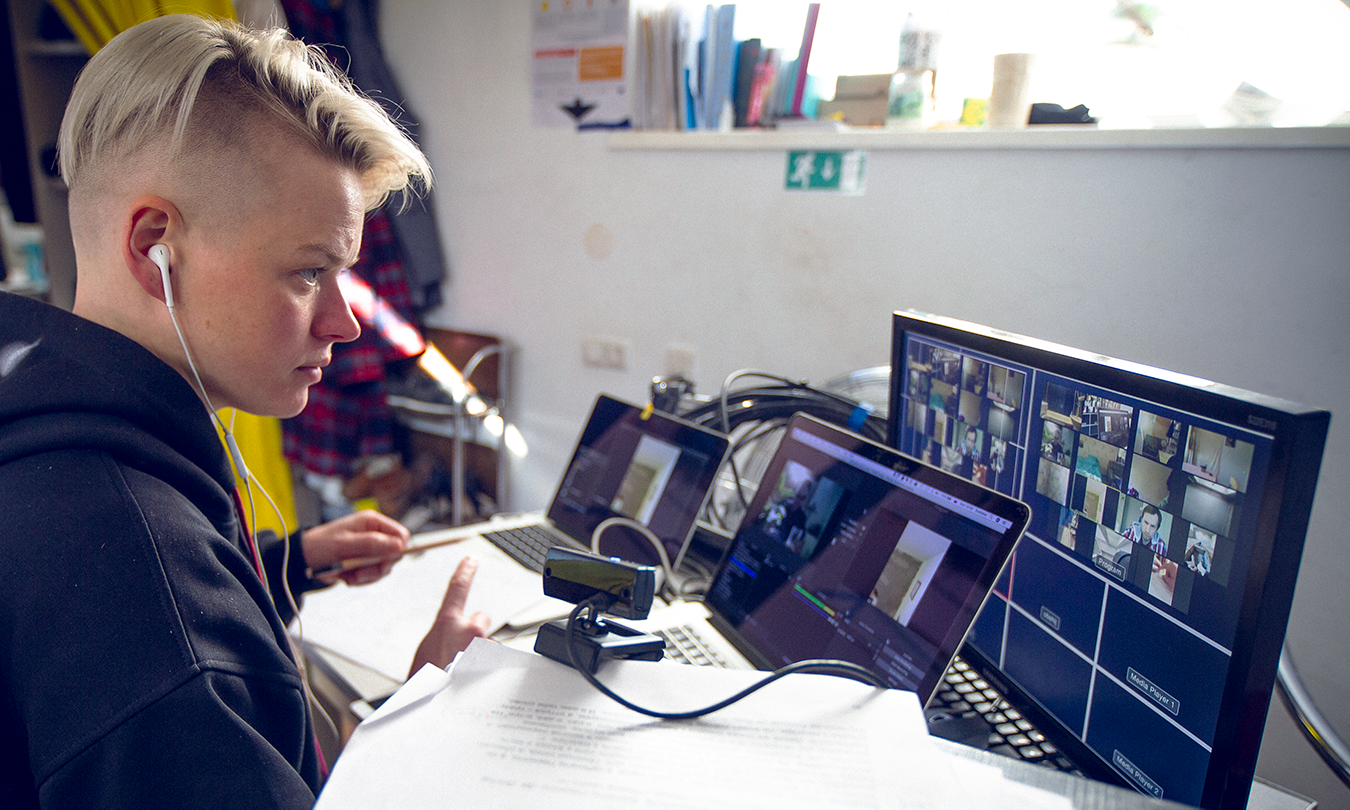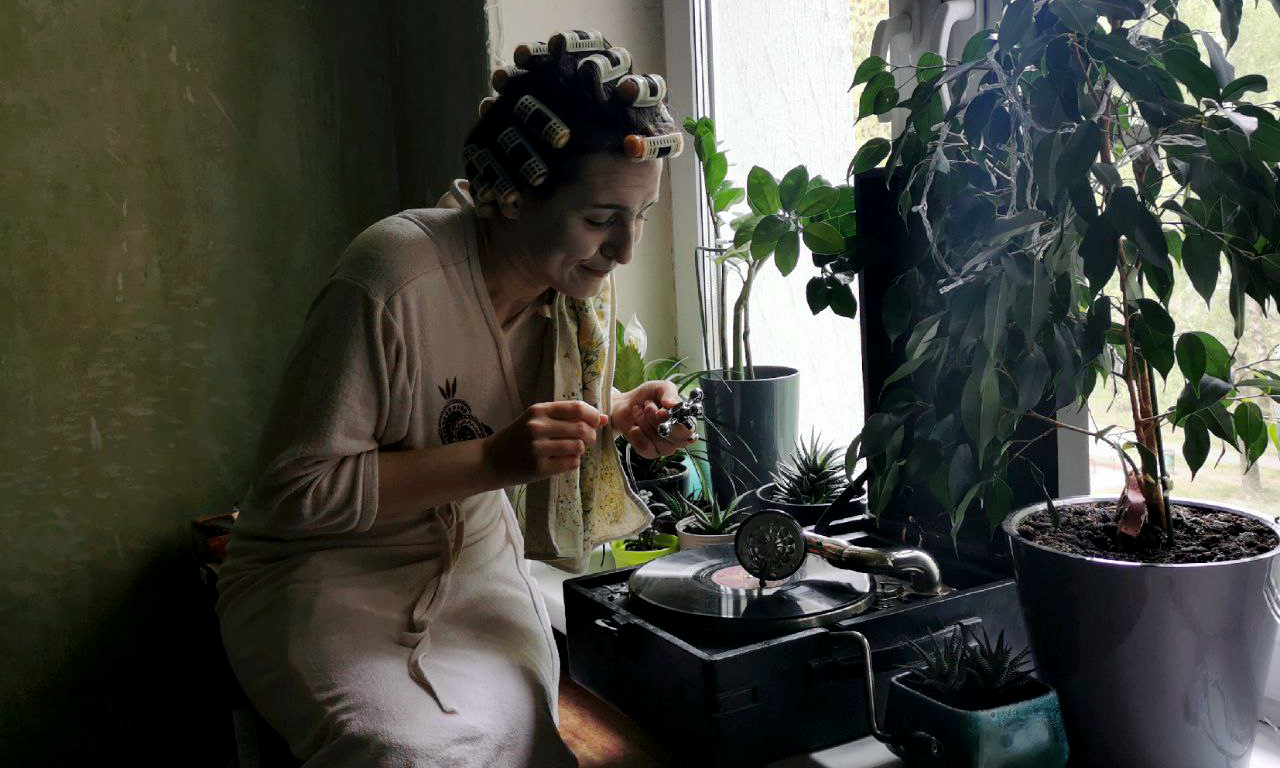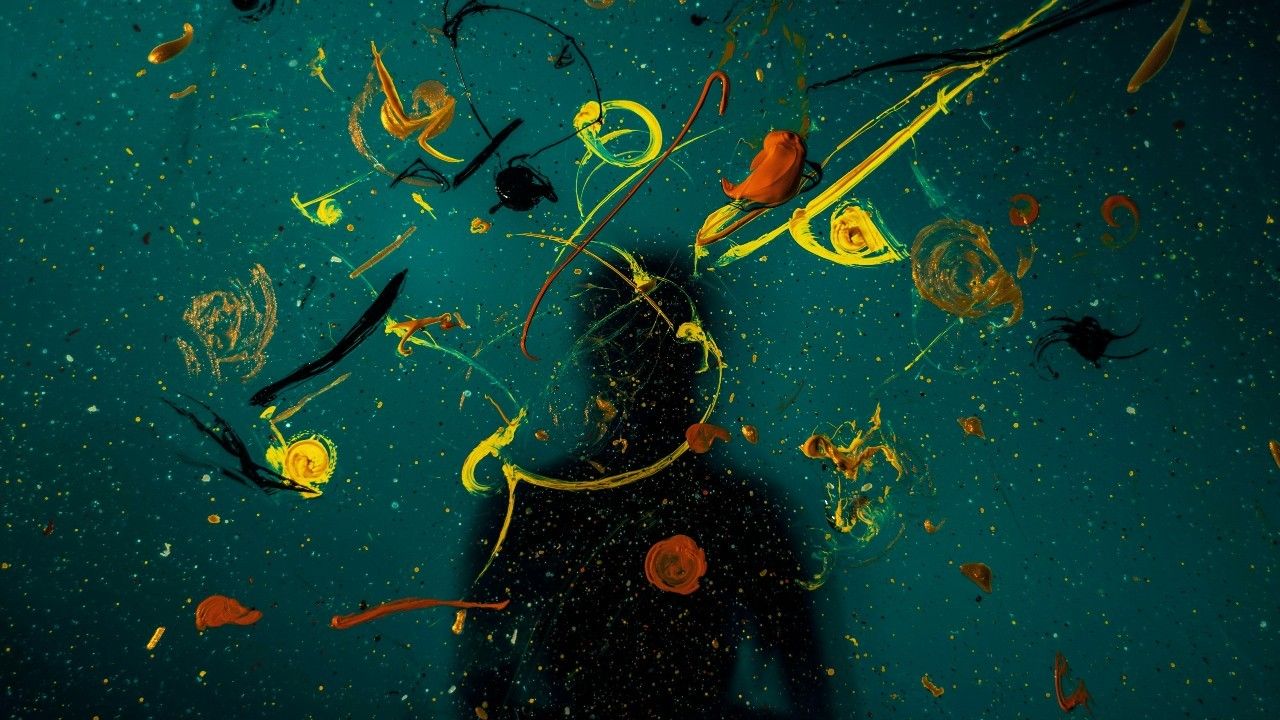This piece, “At Home and in Lockdown with Belarus Free Theatre: The Show Goes On” by Verity Healey, was originally published on HowlRound Theatre Commons on June 30, 2020.
If any theatre company is going to feel at home during COVID-19 and the challenges the pandemic has brought to theatres worldwide, it is going to be Belarus Free Theatre (BFT), an outlawed company based in Belarus and the UK (its artistic directors Natalia Kaliada and Nicolai Khalezin, in fear of their lives, had to seek asylum in Britain in 2011). In Belarus, where dictator President Lukashenko faces national elections in August—and is busy arresting citizens attending opposition rallies—the BFT ensemble is banned from performing and from registering as a theatre company because it produces democracy-promoting plays and global campaigns advancing human rights.
Working out of a small garage in a secret location in Minsk, the country’s capital city, BFT is ineligible to apply for national funding, and ensemble members, continuing to perform illegally and underground, face the very real and constant threat of being arrested by the KGB, tortured, and “disappearing” into the country’s notorious prison system everyday. Enduring such an environment for years has made BFT resilient and given them the ability to adapt quickly to fast-changing circumstances and to be at the forefront of technological developments—Kaliada and Khalezin have been using secure platforms to communicate, rehearse, direct, and livestream performances for the last decade. And whilst BFT also finds it difficult to get funding in the UK, it was awarded COVID-19 emergency funding from Arts Council England (ACE), and its UK staff, eligible for the treasury’s job retention program, have only very recently been furloughed. But the program does not apply to BFT’s ensemble—they all remain in Belarus still working, having received philanthropic donations from global funders.
On top of this, Lukashenko is a COVID-19 denier and has advised his citizens to drive tractors, go to the sauna, and drink vodka to prevent infection. Whilst he has not imposed a lockdown, he is using the virus as an excuse to ban protests of any kind (prescient in the run-up to the elections) and arrest anyone who raises a voice in opposition. This means that, in Minsk, BFT, in tandem with their colleagues in the UK, have voluntarily gone into self-isolation to protect themselves and their families whilst creating work from their living quarters—turning their homes, quite literally, into performance spaces.

In Lockdown
“I get to spend twenty-four hours a day with the people I love, otherwise the lockdown is no different for me,” says Khalezin. It will not come as a surprise then that, since late February, the company has premiered two full-length plays, facilitated and broadcast several online fairy tales with renowned artists such as Stephen Fry, Juliet Stevenson, Will Attenborough, and Sam West for their campaign #LoveOverVirus, and made all of their previous shows accessible for free on YouTube. Though I know BFT quite well and just finished working for them as a freelancer, I have never known them to be so prolific over such a short time—although it is true that one of the plays, Dogs of Europe (DoE) was already one week into an onstage run in Minsk before COVID really hit.
It’s their latest show, though, A School for Fools (ASFF), which is streaming live online, that has recently made the headlines. Adapted from Sasha Sokolov’s 1960s phantasmagoric modernist novel of the same name—which was compared by the New York Times’ theatre critic Ben Brantley to James Joyce’s Ulysses and which was originally distributed via samizdat in the Soviet Union—the story charts the experiences of a young boy living with a dual personality disorder attending an oppressive school, a kind of place that used to exist in Eastern Europe (and still does in Kazakhstan). Through his split personalities, personified by the two characters Bacillus and Nymphaea, readers get to experience his deeply sensual and “present” world made up of real and unreal micro-stories and love fantasies.
The show’s adapter and director, Pavel Haradnitski, tells me it was originally conceived to be what he terms an “offline” production, but when COVID-19 hit the decision was made to make the show online—and its many-layered worlds fit perfectly into the virtual spaces most of us now inhabit. Starring twelve of BFT’s ensemble members, all living in Minsk, in twelve locations (the actors’ mostly small Soviet-style flats, where they live with their young families and cats, who sometimes wander into scenes) and with sixteen different camera setups hosted by Zoom, it is a feat of technical wizardry imagined by Haradnitski’s artistic vision and Sveta Sugako’s broadcasting direction—especially considering Sugako was inventing how to technically make the show work as she went along.
Enduring such an environment for years has made BFT resilient and given them the ability to adapt quickly to fast-changing circumstances and to be at the forefront of technological developments.
From Offline to Online: Artistic Needs and Caring for a Global Audience
But how did it come about? When the pandemic hit, most theatres, at least in the UK, spent weeks paralyzed by shock, underprepared to deal with the lockdown after Prime Minister Boris Johnson, without warning, advised the public to stop seeing shows. This is not the industry’s fault, Khalezin is at pains to point out, it is just that it does not have the technical know-how to continue to operate in such conditions. For BFT, though, stopping has never really been an option, even when its ensemble entered self-imposed quarantine in Minsk or when ASFF cast member Nastasya Korablina came down with COVID-19 herself (she insisted on continuing to work).
Haradnitski calls the need to do ASFF “a desire to act, because even in two months, actors can lose their skills.” Previous conversations had with Haradnitski, Sugako, and Nadia Brodskaya, the producer for ASFF, have also revealed to me that for everyone in the ensemble BFT is a way of life, 24/7. There is no doubt that being a rep company—they can perform old or new shows at any time, and if they are rehearsing for one, you can pretty much guarantee they are also devising another—strengthens their collaborative, can-do, and need-to-work attitude. Some ensemble members have also been part of the group since the very beginning, and once actors join through the acting studio Fortinbras, they have a tendency to stay. “This means,” says Haradnitski, “that I don’t need to tell some of my actors what to do, they just do it.”

Sugako tells me that accepting the challenges ASFF brought to them all is indicative of the company’s ability to just get on with it. “We are not waiting for someone to give us money,” she says from her dacha deep in the Belarusian countryside. “Of course we need the funding, and not to have it means we go without, but it doesn’t stop us, we find new ways to work.” Kaliada later clarifies that ASFF was rejected by a new digital ideas online funding strand in the UK, but the need to create made ASFF happen anyway.
Funnily enough, everyone I have been speaking to at BFT over the last three months has mentioned this need—from David Lan, who gave BFT’s exiled directors a home at the Young Vic in London when he was the artistic director, to Haradnitski, to Sugako and her need to “get on with it.” But Kaliada expands some more on the thinking behind #LoveOverVirus and especially ASFF: “When COVID hit, we thought, What can we do for our audiences?” She and Khalezin, observing the plight of elderly and isolated individuals in the UK, came up with a five-point strategy that included supporting the audience in Britain, Belarus, and all over the world and sharing a similar emotional experience with them. Indeed, at the premiere of ASFF, audiences from over thirty countries tuned in. “We are pretty sure,” she says to me over Zoom, “that 100 percent of the population is experiencing some form of mental health problems during this pandemic. People are afraid to leave their homes. So it became about caring for our audiences.”
When COVID-19 hit the decision was made to make the show online—and its many-layered worlds fit perfectly into the virtual spaces most of us now inhabit.
Technical Difficulties
But ASFF is not just an ideological road map out of the pandemic—i.e., using technology and social media platforms in new ways to bring live drama to people at home via laptops and devices. It is also a way of doing theatre that, as Khalezin says, we may have to return to more and more if the world faces other pandemics and climate breakdown emergencies. But Zoom is not custom-made to handle large-scale live performances—it was invented purely for business meetings and conferences and it lacks the interfaces custom-made platforms might have (there are ones being developed especially for BFT, but they were not ready in time for the pandemic). This means that more stable options will have to be found, especially as, in its pandemic performances, the company came up against unforeseen technical issues.
One of Sugako’s and Haradnitski’s main difficulties, for example, was working out how to let the actors know what marks to hit, especially when it was required for actors to make it look like they were physically interacting with each other. In the end, Sugako had to use a webcam, pointed at her Zoom host interface, which allowed her to share her screen with the actors so they could see they were in the right place to make it look like they were connecting across frames. The other issue is Zoom’s propensity to kick people off the platform if their internet connection drops—which anyone who has ever been to Belarus will know is a common occurrence. And to make things more complicated, Sugako had to line up the sixteen devices—laptops, phones—in a particular order for actors to hit their cues. If they get out of sync, the whole show is scrambled.
To circumnavigate this and prevent overload, Sugako did two things. One: some of the scenes were prerecorded to be used as backup, to cover for such an event and to allow time for all the actors to come back online if one actor was kicked out. (“And it worked,” says Kaliada. “In previews we had four dropouts and in the premiere one, and no one noticed.”) And two: Sugako streamed the show live via a YouTube feed for the audience, which meant she could also crop the picture slightly, so audiences did not see “backstage”. Sugako was trained in broadcasting live events from the team at La MaMa in NYC in 2016, but her courage, along with Haradnitski’s ability to push boundaries, make mistakes, and experiment, is what resulted in this groundbreaking production.

Is It Theatre, Just Not as We Know It?
Zoom is perfect for this play. The company’s choice to experiment with close-ups, point of view, and tracking shots allows the audience to be in the characters’ heads, the split-screen option increases the sense of dislocation of space, and the cinematic mise-en-scène helps to create a dreamy mood—one shot included a lovely hard dissolve from a twirling umbrella to a revolving record player, and another included an Andrei Tarkovsky–like spiriting away into the air via a drone. But, says Haradnitski: “Theatre for me must have two components. One: it must be a live performance. Two: the performers must be able to interact with their audience.” Sugako disagrees slightly, for her the live element is enough. “It is theatre because no performance will be the same,” she says. “We can play and I know that each time we will discover something new.”
But no matter how successful it seems, I get the impression from Khalezin that nothing can make up for the real McCoy. Online live theatre is a new phenomenon “but the stage version will be different,” he says. Still, this technically improbable event brought with it its own nice surprises even though the premiere and press night did not have the same buzz one gets from being in a physical space. The show is free, which is part of BFT’s commitment to making things accessible. And upon booking a ticket, the audience member is asked if they need British Sign Language interpretation or not. When you sign in to the YouTube channel, you can chat with others in the chat box and also see who else signs in—which has included Stephen Fry (who was writing in emoji).
In my experience, things seemed a lot more informal than out in the real world—bigger in the sense that audiences from all over the world were watching with me and yet smaller, and more informal, because the point of convergence was a small virtual screen with a chat box where I could actually know by name who was watching with me. Suddenly, although I could not see the audience, I knew who they were and it brought a different kind of intimacy than watching in a physical theatre. The experience is also a great leveler—as Kaliada says with a twinkle in her eye, there are no “special best seats” for the critics. Even the Q&A at the end, which takes place on Zoom for everyone, could go on for as long as people wanted. And it is always a pleasurable thrill for theatregoers to hear someone say, “Okay, everyone else can go, but the cast need to stay for notes.” Over virtual space operating across thousands of miles, theatre suddenly seemed so close. This might not be the theatre for the purists, but other journalists have said to BFT that ASFF is the first most concrete road map they have seen as a positive way out of theatre’s current paralysis.
This technically improbable event brought with it its own nice surprises even though the premiere and press night did not have the same buzz one gets from being in a physical space.
Further Apart, but Closer Together
According to Khalezin, the challenges thrown up by ASFF has helped the company become even more resilient—Sugako and Haradnitski both note they have had to learn to be more patient with fellow ensemble members who are less skilled at fixing lights or solving technical issues. “We can’t just rush in and do it for them, we had to learn to have some empathy,” says Haradnitski. And, even though everyone is separated physically, everyone feels closer to each other. “We see inside people’s houses, which normally we would never do, and we see people in their natural state too and it’s more intimate,” says Sugako. Indeed, BFT was having virtual cigarette breaks together and even eating together too.
When I ask how come BFT can do all this so quickly, Kaliada responded with: “We don’t react, we provoke and inspire.” And the company’s general manager in London, Aaron Gordon, jokingly told me BFT can do in a flash what it takes UK theatres three weeks debating with a focus group to do. But maybe BFT’s positive approach is catching on. Kaliada tells me the UK theatre industry is responding positively to the crisis by looking outwards, helping independent producers and inviting more women and freelancers onto Zoom calls and into spaces they might otherwise never get to be in, in an effort to find a way forward. Her worry though is that when COVID-19 retreats, the industry might return to being inward-looking, or even, she sighs, back to the dreaded “normal” people keep going on about, which she believes does not exist anyway. “Normal” for her has no value.

One thing for sure is that BFT won’t be returning to exactly how they were before all this began; it is not within their nature. When I spoke to Kaliada, Khalezin, Haradnitski, and Sugako a day after ASFF’s premiere, all of them were flushed with creative success and well-being, and the sense of having achieved something groundbreaking was palpable. It is unbelievable that a company under great pressure in a dictatorship during COVID-19—and in almost constant fear of being beaten, imprisoned, and worse—can still look outward and communicate with others in different parts of the world through #LoveOverVirus and ASFF, bringing people together even in these tragic times when so many are dying.
If this is not the roadmap for a new way of doing theatre, I don’t know what is. Over Zoom, Kaliada is tired but smiling broadly at me. “We just put on a show in Belarus and the rest of the world saw it beamed live from our country,” she says in wonder. That, even a few months ago, was incomprehensible, perhaps unimaginable.
Author
-

Verity Healey is a London-based writer and filmmaker who writes for HowlRound, Ministry of Counterculture, The London Economic and Exeunt. verity is also a published short story writer (anthology).
View all posts









